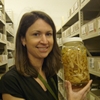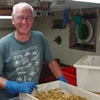General Description
Rostrum acute, 3 times as long as broad at base, separated from orbital hoods by deep short grooves overhung by base of rostrum; orbital hoods with converging acute teeth, reaching half length of rostrum; rostrum-hood margins short and convex. Large claw (chela) laterally compressed; lower margin slightly concave, irregular proximally; upper margin with longitudinal groove; without lateral and medial teeth near dactylar articulation; with only few scattered setae. Small claw (chela) not of balaeniceps form. Maxilliped 3 with penultimate article not lobed on the lower margin. Dull orange and with orange-red chelipeds. Up to 3.5 cm long.
Biology
Snapping shrimps or pistol shrimps are immediately distinguished from other families by having one claw much larger than the other, the larger claw cylindrical and with a parrot-beak-like finger. The snapping apparatus on the claw involves a piston at the base of the moveable finger that fits into a cavity of the fixed finger. When clicked closed by the strong muscles in the palm, a sudden jet of water is expelled to stun its prey, such as crabs and fishes. A sharp click is heard at the same time and may even be audible to us when walking over mudflats where the shrimps can be common.
Habitat
Intertidal to 29 m depth.
Soft substrates
Coastal shores
Distribution guide
Southern temperate oceans, including southern Australia.
Species Group
Prawns, shrimps, lobsters › Shrimps
Depth
Shore (0-1 m)
Shallow (1-30 m)
Water Column
Max Size
3.5 cm
Diet
Organic matter
Commercial Species
No
Global Dispersal
Recorded in Australia
Species Code
MoV 722
Conservation Status
- DSE Advisory List : Not listed
- EPBC Act 1999 : Not listed
- IUCN Red List : Not listed









